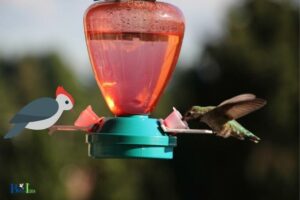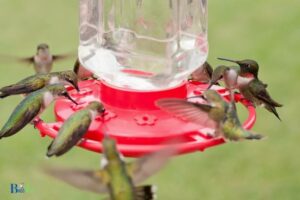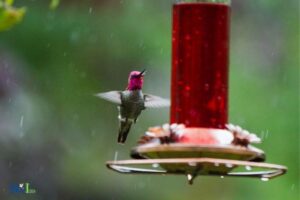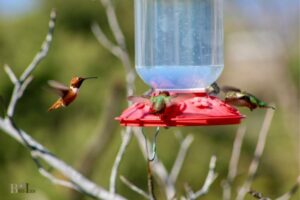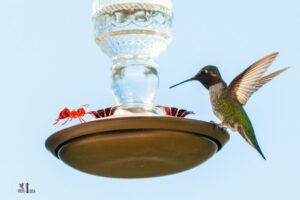Do Hummingbirds Fight Over Feeders: Yes, 6 Behaviors!
Yes, hummingbirds do fight over feeders.
These tiny birds are known for their territorial and aggressive behavior, especially when it comes to defending their food sources.
They will chase away any intruders, including other hummingbirds and insects, to protect their territory and ensure that there’s enough nectar available for themselves.
This behavior is particularly common during the breeding season when they need to maintain their energy levels for courtship and raising their young ones.
It’s a fascinating glimpse into the competitive side of these beautiful, tiny creatures.
6 Behaviors of Hummingbirds Fight Over Feeders
| Behavior | Causes | Consequences | Solutions |
|---|---|---|---|
| Aggression | Territoriality | Smaller or weaker birds are deterred from the feeder | Place multiple feeders in separate locations |
| Chasing | Competition for limited resources | Increased stress for the chased bird | Provide more feeding stations |
| Hovering close | Assert dominance | Birds may waste energy in aerial battles | Use feeders with multiple ports |
| Diving at others | Protecting their food source | Potential injury to other birds | Place feeders out of sight from each other |
| Vocalizing threats | Communication of territory | An increased level of tension among birds | Keep feeders clean to attract more birds |
| Perching nearby | Monitoring the feeder | Other birds may feel intimidated | Use feeders with no perches to discourage lingering |
Key Takeaway
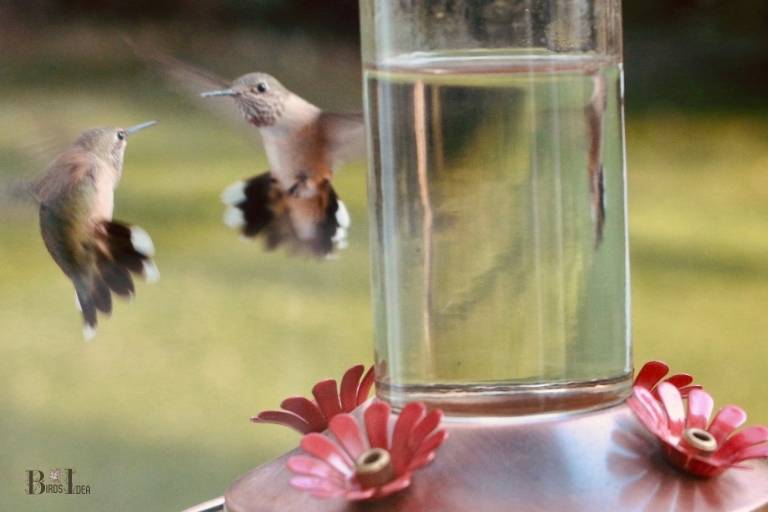
Five Facts About: Fight Over Feeders
How Hummingbirds Compete for Feeders?
Hummingbirds, known for their agility and vibrant colors, are highly competitive when it comes to securing food sources.
As these tiny birds require a lot of energy to maintain their rapid wingbeats, they fiercely compete for the nectar provided by feeders, often exhibiting territorial behavior.
These competitive interactions typically involve chasing, aerial displays, and aggressive vocalizations, all of which serve to communicate dominance and protect their feeding territories.
- Chasing: One bird will pursue another to drive it away from the feeder.
- Aerial displays: These involve dive-bombing, hovering, and other acrobatics to assert dominance.
- Aggressive vocalizations: Hummingbirds will use high-pitched sounds to establish their presence and deter others from approaching the feeder.
“Hummingbirds are fiercely territorial, especially around food sources like nectar feeders. They will fiercely defend their feeding territory and even chase off other hummingbirds from the area.”
The Spruce
What Aggressive Behaviors Do Hummingbirds Display for Feeders?
Hummingbirds are known for their aggressive behaviors, especially when it comes to defending their territory and food sources.
These tiny birds are fiercely competitive and will often display aggressive behaviors when sharing feeders with other hummingbirds.
Some of the common aggressive behaviors include chasing, air combat maneuvers, mid-air confrontations, and vocal outbursts.
- Air combat maneuvers: They engage in aerial acrobatics to intimidate and fend off competitors.
- Mid-air confrontations: Face-to-face confrontations while hovering can lead to physical contact and grappling.
- Vocal outbursts: Hummingbirds will emit loud high-pitched chirps to warn and deter rivals.
What Environmental Factors Lead to Hummingbird Fighting?
Hummingbirds are known for their vibrant colors, rapid wing movements, and territorial behavior.
They often engage in aggressive behavior or fights to protect their feeding territories, especially during mating season.
There are several environmental factors that may contribute to hummingbird fighting over feeders.
- Resource scarcity: When flower nectar or other food sources are scarce, hummingbirds are more likely to fight over feeders to secure enough food for themselves.
- Feeder placement: If feeders are placed too close together, it may be easier for one hummingbird to defend multiple feeders, increasing the likelihood of aggression and fighting.
- Mating season: During the mating season, male hummingbirds become particularly territorial and may chase away other males or even females to protect their feeding territories.
- Feeder design: Some hummingbird feeders may not have enough ports for multiple birds to feed at the same time, causing increased competition and aggression.
What Can Be Done to Reduce Hummingbird Competition at Feeders?
Hummingbirds are known for their territorial behavior, especially when it comes to their food sources.
To reduce competition and fighting at feeders, there are several strategies that can help maintain a peaceful environment for these beautiful creatures:
- Use multiple feeders: Installing more than one feeder at different locations in your yard or garden can help prevent overcrowding and give more hummingbirds access to food sources.
- Space feeders apart: Keep feeders at least 10-12 feet apart to minimize the possibility of one bird dominating all the feeders. This will encourage other hummingbirds to visit each feeder separately.
- Vary feeder heights: Position feeders at varying heights, as some species of hummingbirds may prefer to feed at specific heights.
- Provide natural food sources: Planting flowers and maintaining a diverse garden will supplement the nectar from feeders and help to reduce competition.
- Use different feeder designs: Purchase feeders with different styles and shapes to attract a variety of hummingbird species and discourage territorial behaviors.
- Keep feeders clean and well-stocked: Regularly clean and refill your feeders to maintain a healthy environment and attract more hummingbirds, thus promoting equal access to food sources.
Pro tip: Do not use red food dye in your hummingbird nectar, as it can be harmful to their health. Instead, opt for red-colored feeders to attract hummingbirds without causing harm.
birdsidea
What are the Benefits of Setting Up Multiple Hummingbird Feeders?
Setting up multiple hummingbird feeders has several benefits, particularly if you have noticed hummingbirds fighting over a single feeder.
This behavior can be attributed to their territorial nature, as they compete for valuable nectar resources.
By providing multiple feeders, you can minimize conflicts between hummingbirds and ensure that they can all enjoy the nectar without disrupting each other.
- Reduce territorial disputes: Multiple feeders help keep hummingbirds from fighting over one food source.
- Attract more hummingbirds: More feeders increase the chances of attracting a variety of hummingbird species.
- Support their energy needs: Hummingbirds have high metabolism rates, so providing multiple feeders supports their energy requirements.
- Better observation opportunities: Having several feeders allows you to observe and learn about more hummingbirds’ behavior at once.
- Aid in population growth: Multiple feeders provide better support for hummingbird populations in your area, which helps maintain biodiversity.
What Safety Precautions Should be Taken When Placing Hummingbird Feeders?
When placing hummingbird feeders, it’s essential to ensure the safety of both the hummingbirds and the environment.
Hummingbirds can be territorial and may fight over feeders, but with proper precautions, you can minimize these conflicts and create a safe and welcoming space for these beautiful creatures.
The following safety measures can be implemented for an optimal hummingbird feeder setup.
- Choose the right location: Place feeders at least 10-15 feet apart from each other to minimize confrontations between hummingbirds.
- Keep feeders clean: Regularly clean and refill feeders to prevent the growth of bacteria and mold, which can be harmful to the birds.
- Use proper nectar: Do not use honey, artificial sweeteners, or coloring in the sugar water, as they can be harmful to the birds. Use a 1:4 ratio of sugar to water for the nectar recipe.
- Provide natural food sources: Plant native flowering plants in your garden to offer natural food sources for hummingbirds, thus reducing the competition for feeders.
- Prevent window strikes: Place feeders either within 3 feet or more than 10 feet away from windows to reduce the risk of hummingbirds flying into them.
- Keep ants and bees away: Use an ant moat or bee guards on your feeder to discourage these unwanted visitors without harming them.
- Protect from predators: Place feeders out of reach from cats and other predators, and avoid placing them in areas with dense foliage where predators may hide.
According to a study published in the journal Behavioral Ecology, hummingbirds spend up to 25% of their daily energy budget fighting over resources like feeders or flowers.
birdsidea
Why do hummingbirds dive bomb each other?
Hummingbirds are known for their territorial behavior and will often dive bomb each other to assert dominance over food sources.
This is especially true when it comes to feeders, which are highly sought after by these tiny birds.
When one hummingbird perceives another as a threat to its food source, it may engage in aggressive behaviors such as dive bombing, chasing, and vocalizations to drive the other bird away.
To prevent this, it’s recommended to hang multiple feeders in different areas to reduce competition and give each bird access to its own food source.
Additionally, keeping the feeders clean and well-stocked can help reduce the likelihood of aggressive behavior.
Can hummingbird feeders be close to other feeders?
Hummingbirds can be territorial creatures and may fight over resources, including feeders.
It is recommended to place hummingbird feeders at different locations to reduce territorial aggression and give each bird sufficient space to feed.
However, if you must place multiple feeders in close proximity, there are several tips to minimize fighting:
- Place feeders at different heights to create some distance between birds.
- Use feeders with multiple ports to allow more birds to feed at the same time.
- Add more feeders to the area to distribute the birds and reduce competition.
- Choose feeders with bee and ant guards to prevent other insects from swarming the feeders, which can attract more hummingbirds.
By following these tips, it is possible to have multiple hummingbird feeders in close proximity while minimizing territorial aggression and ensuring each bird has access to enough food.
Which hummingbird feeder is best?
Hummingbirds tend to be quite territorial and may engage in aggressive behavior such as fighting over food sources like feeders.
Therefore, it’s important to choose a hummingbird feeder that not only attracts the birds but is also designed to minimize aggression and competition among them.
The best hummingbird feeders often have features like multiple feeding ports, perches, and enough capacity to accommodate several birds at once.
Additionally, the color and design of the feeder can also affect hummingbird behavior.
It’s recommended to choose a brightly colored feeder with a design that mimics flowers, which is what hummingbirds naturally feed on.
Some of the best hummingbird feeders on the market include:
- First Nature 3051 Hummingbird Feeder
- Perky-Pet 203CPBN Pinch Waist Glass Hummingbird Feeder
- Aspects 367 HummZinger Ultra Hummingbird Feeder
- Best-1 8oz. Hummingbird Feeder
It’s also important to regularly clean and maintain the feeder to prevent the spread of disease and ensure the birds have access to fresh nectar.
Why does a hummingbird hum?
Hummingbirds are called such because of the humming sound they make when they beat their wings at high frequencies.
Males can often be seen diving and swooping over feeders to establish dominance and ward off rivals in their territory.
This aggressive behavior is common among hummingbirds and can lead to spectacular aerial fights.
However, while the hum may be a warning sound, it is not the cause of their aggressive behavior.
Instead, it is believed that the hum is produced by the rapid movement of their wings and the vibration that it creates.
So the next time you hear a hummingbird’s hum, take a moment to appreciate this unique sound that comes from such a small but fierce bird.
- Hummingbirds make a humming sound when they beat their wings at high frequencies.
- Males often fight over feeders to establish dominance and ward off rivals in their territory.
- The hum is not the cause of their aggressive behavior, but rather a byproduct of the rapid movement of their wings.
- Appreciate the unique sound that comes from such a small but fierce bird.
FAQ for Do Hummingbirds Fight Over Feeders
Do hummingbirds fight over feeders?
How do hummingbirds fight?
What can I do to prevent fights over the feeder?
You can also try placing the feeders further apart, filling the feeders more regularly, provide feeders with different types of nectar and placing feeders at a variety of heights.
What should I do if I see a hummingbird fighting?
Conclusion
In conclusion, hummingbirds do compete for feeders and can display aggressive behaviors towards each other.
Environmental factors such as limited resources, overcrowding, and territoriality can further increase competition.
To reduce hummingbird fighting, multiple feeders can be set up in different locations and cleaned regularly.
It is also important to take safety precautions when placing the feeders to prevent harm to the birds and other animals. Setting up multiple feeders not only reduces competition but also attracts a greater variety of hummingbirds to the area.
By following these tips, we can create a harmonious environment for these beautiful creatures to thrive.

